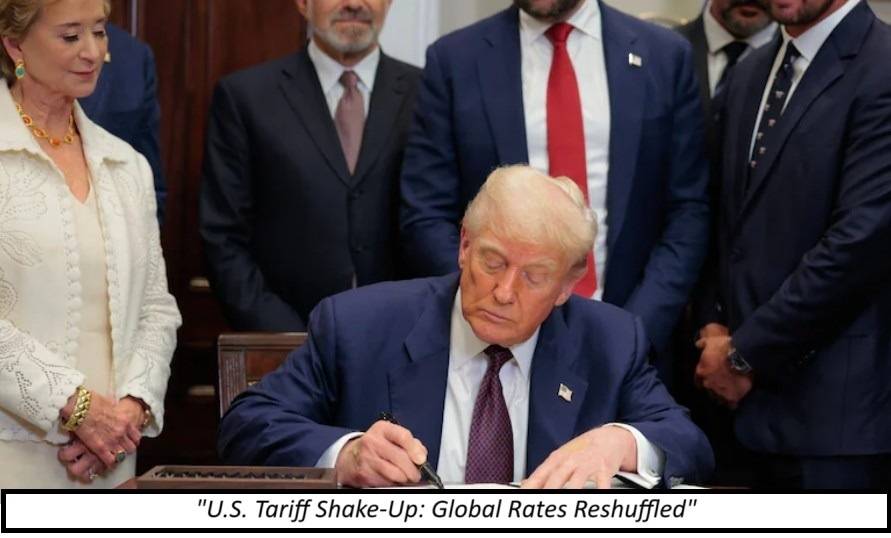New tariff order raises rates up to 50% for key partners, slashes some duties, and keeps India unchanged despite stalled talks.
Trump’s New Tariff Strategy Shakes Global Trade Landscape
In a bold move to recalibrate U.S. trade relationships, President Donald Trump has signed a sweeping executive order imposing revised import tariffs on 69 countries. The new tariff structure—ranging from 10% to as high as 50%—is scheduled to take effect within seven days.
While most countries saw substantial changes, India retained its 25% tariff rate. In contrast, Pakistan saw a notable reduction—from 29% to 19%—as part of a broader strategic realignment.
📈 Key Tariff Highlights at a Glance
- India: Holds steady at 25% amid stalled negotiations
- Pakistan: Slashed from 29% to 19%
- Brazil: Hit with 50%, but key sectors like energy and aviation excluded
- Canada: Tariffs on certain goods increased to 35%
- Mexico: Granted a 90-day reprieve for broader trade negotiations
- South Korea: Accepted 15% tariff in exchange for $350 billion U.S. investment
- Switzerland: Imposed 39% tariff
- Syria: Faces the highest rate—41%
- Taiwan & Vietnam: 20%
- European Union: Special rates tied to specific product categories
🛑 India Holds Firm Despite Pressure
India’s tariff rate remains unchanged at 25%. According to U.S. officials, negotiations stalled over agricultural market access and India’s energy dealings with Russia. Trump hinted at future penalties over New Delhi’s purchase of Russian oil.
Despite talks continuing, the Indian government has vowed to protect its farm sector, drawing criticism from opposition parties and triggering a minor dip in the rupee’s value.
Pakistan Sees a Strategic Tariff Cut
In a notable shift, the U.S. lowered tariffs on Pakistani goods from 29% to 19%, possibly reflecting diplomatic recalibration in the region. This reduction could potentially boost bilateral trade and offer relief to Pakistan’s struggling export economy.
🌎 Trump’s Statement on Global Trade Imbalance
Trump justified the tariff restructuring by saying that many countries had failed to present “sufficiently fair” trade terms or align with U.S. national and economic security interests. Goods from all other nations not specifically listed will default to a 10% tariff.
“Some partners have not addressed trade imbalances or aligned with U.S. security priorities,” the executive order stated.
🔍 Canada and Mexico: A Tale of Two Strategies
- Canada: Targeted with a 35% tariff on fentanyl-related goods due to alleged failure to cooperate on narcotic control.
- Mexico: Granted a temporary 90-day tariff reprieve after President Trump’s call with President Claudia Sheinbaum. However, the U.S. will maintain 50% tariffs on metals and 25% on autos not compliant with USMCA.
Brazil Punished, But Not Across the Board
Brazil has been hit with a 50% tariff in response to its treatment of former President Jair Bolsonaro, a close Trump ally. Still, critical sectors like aircraft manufacturing, energy, and orange juice were spared harsher duties.
South Korea Agrees to 15% Tariff and Major Investment
As part of a compromise, South Korea accepted a 15% tariff on exports to the U.S.—down from the threatened 25%—in exchange for a massive $350 billion investment in American infrastructure and industries.
China Deadline Looms
While the new order doesn’t finalize U.S.-China trade terms, a deadline looms. Beijing has until August 12 to strike a comprehensive deal or risk another wave of tit-for-tat tariffs. Talks are currently focused on rare earth mineral access and technology flows.
📋 Full U.S. Tariff Adjustment List (Effective in 7 Days)
| Country / Territory | Revised Tariff Rate |
|---|---|
| Afghanistan | 15% |
| Algeria | 30% |
| Angola | 15% |
| Bangladesh | 20% |
| Bolivia | 15% |
| Bosnia and Herzegovina | 30% |
| Botswana | 15% |
| Brazil | 50% (Exempt: aviation, energy, orange juice) |
| Brunei | 25% |
| Cambodia | 19% |
| Cameroon | 15% |
| Chad | 15% |
| Costa Rica | 15% |
| Côte d’Ivoire | 15% |
| Democratic Republic of the Congo | 15% |
| Ecuador | 15% |
| Equatorial Guinea | 15% |
| European Union (Goods >15% Column 1) | 0% |
| European Union (Goods <15% Column 1) | 15% minus Column 1 duty |
| Falkland Islands | 10% |
| Fiji | 15% |
| Ghana | 15% |
| Guyana | 15% |
| Iceland | 15% |
| India | 25% |
| Indonesia | 19% |
| Iraq | 35% |
| Israel | 15% |
| Japan | 15% |
| Jordan | 15% |
| Kazakhstan | 25% |
| Laos | 40% |
| Lesotho | 15% |
| Libya | 30% |
| Liechtenstein | 15% |
| Madagascar | 15% |
| Malawi | 15% |
| Malaysia | 19% |
| Mauritius | 15% |
| Moldova | 25% |
| Myanmar (Burma) | 40% |
| Mozambique | 15% |
| Namibia | 15% |
| Nauru | 15% |
| New Zealand | 15% |
| Nicaragua | 18% |
| Nigeria | 15% |
| North Macedonia | 15% |
| Norway | 15% |
| Pakistan | 19% (↓ from 29%) |
| Papua New Guinea | 15% |
| Philippines | 19% |
| Serbia | 35% |
| South Africa | 30% |
| South Korea | 15% (Deal includes $350B U.S. investment) |
| Sri Lanka | 20% |
| Switzerland | 39% |
| Syria | 41% (Highest rate) |
| Taiwan | 20% |
| Thailand | 19% |
| Trinidad and Tobago | 15% |
| Tunisia | 25% |
| Turkey | 15% |
| Uganda | 15% |
| United Kingdom | 10% |
| Vanuatu | 15% |
| Venezuela | 15% |
| Vietnam | 20% |
| Zambia | 15% |
| Zimbabwe | 15% |
📢 What Comes Next?
According to White House officials, additional trade deals are in progress and will be announced soon. The administration is positioning these “reciprocal tariffs” as tools to push trading partners toward “fairer” trade practices.
“We have some deals,” a senior official said. “But only the President will announce them.”
📝 In Summary
Trump’s revised tariff order signals a renewed push for trade realignment centered on U.S. economic interests. With India staying at 25%, Pakistan seeing relief, and tensions building with China and Canada, global markets may brace for further disruptions.
Also Read : Trump Calls India, Russia ‘Dead Economies’ — Russia Responds with Chilling ‘Dead Hand’ Warning



